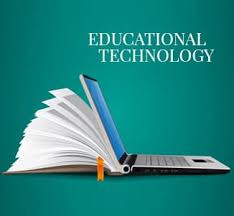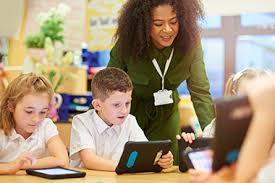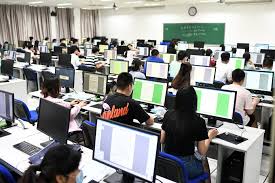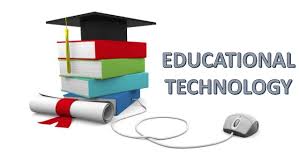Impacts of Educational technology
Educational Technology: Transforming Learning in the 21st Century
In an age where Impacts of Educational technology influences nearly every aspect of our lives, education is no exception. Educational technology, often referred to as impacts of educational technology , represents the use of digital tools and platforms to enhance teaching and learning experiences. It has revolutionized classrooms, offering new ways to deliver knowledge, assess progress, and foster collaboration.

What is Impacts of Educational Technology?
Impacts of Educational technology refers to the integration of technology into the educational environment to support and improve learning. This includes hardware like computers, tablets, and interactive whiteboards, as well as software such as learning management systems (LMS), virtual classrooms, educational apps, and artificial intelligence (AI)-based tools.
1.Benefits of Impacts of Educational Technology
-
Improved Accessibility and Flexibility
Ed Tech breaks down geographical and physical barriers. Students can now access quality education from anywhere in the world through online platforms like Khan Academy, Coursera, and Google Classroom. This flexibility is especially beneficial for remote learners and individuals with disabilities. -
Personalized Learning
One of the major advancements in educational technology is the ability to tailor content to individual learning styles and paces. Adaptive learning platforms analyze student performance and adjust content accordingly, ensuring more effective learning outcomes. -
Enhanced Engagement
Digital tools make learning interactive and engaging. Gamified learning apps, virtual reality (VR) simulations, and multimedia content can transform a dull lecture into an exciting, immersive experience that captures students’ attention. -
Collaboration and Communication
EdTech facilitates easier communication between teachers, students, and parents. Tools like Zoom, Microsoft Teams, and Edmodo enable real-time interaction and feedback, even beyond the classroom walls. -
Efficient Assessment and Feedback
Teachers can use online quizzes, surveys, and data analytics to evaluate student performance quickly and accurately. This immediate feedback helps students identify areas for improvement and take corrective action faster.

2.Challenges in Implementing Impacts of Educational Technology:
While the benefits are significant, the integration of Impacts of Educational Technology also presents several challenges:
-
Digital Divide: Not all students have equal access to technology or internet connectivity, leading to inequalities in educational opportunities.
-
Training and Support: Teachers need proper training and ongoing support to effectively use technological tools.
-
Over-reliance on Technology: Excessive screen time and reduced face-to-face interaction may hinder the development of social and emotional skills.
-
Privacy and Security: With increased use of digital platforms comes the risk of data breaches and cyber threats, raising concerns about student privacy.
3.The Future of Impacts of Educational Technology
The future Impacts of Educational Technology is promising, with trends such as:
-
Artificial Intelligence and Machine Learning for intelligent tutoring systems and predictive analytics.
-
Augmented and Virtual Reality for immersive learning experiences in science, history, and medicine.
-
Blockchain for secure credential verification and academic records.
-
Micro learning and Mobile Learning to cater to shorter attention spans and on-the-go education.
Key Features of Impacts of Educational Technology:
-
Focuses on hands-on learning and problem-solving.
-
Involves understanding how things work, how they are made, and how to use tools and systems safely and effectively.
-
Encourages skills like critical thinking, innovation, teamwork, and technical literacy.
- Often includes topics such as engineering, robotics, mechanics, computer science, and design thinking.
-
- Examples include:
-
Online learning platforms (like Google Classroom or Modle)
-
Interactive whiteboards and smart classrooms
-
Educational apps and games
-
Virtual and augmented reality for immersive learning
-
Artificial intelligence for personalized learning paths

4.Goals of Educational Technology:
- To make learning more engaging and interactive
- To support different learning styles and paces
- To improve access to quality education
- To help teachers with planning, assessment, and communication.
1. Improve Teaching and Learning in Impacts of Educational technology
-
Enhance the teaching process through digital tools and multimedia.
-
Make learning more engaging, interactive, and effective.
2. Facilitate Individualized and Personalized Learning
-
Adapt learning experiences to meet the needs, pace, and interests of each student.
-
Use AI and data analytics to track progress and guide instruction.
3. Increase Access to Education
-
Provide remote and online learning opportunities for students regardless of location.
-
Support inclusive education for learners with disabilities or special needs.
4. Enhance Teacher Efficiency
-
Help educators with lesson planning, assessments, grading, and communication.
-
Offer tools for professional development and training.
5. Encourage Student-Centered Learning
-
Shift the focus from teacher-led instruction to active, student-driven learning.
-
Promote critical thinking, collaboration, and creativity.
6. Foster Technological Literacy
-
Prepare students to understand, use, and create technology responsibly and effectively.
-
Develop essential 21st-century skills like coding, data analysis, and digital communication.
7. Support Continuous Learning
- Enable lifelong learning through flexible, on-demand resources.
- Make education available beyond the traditional classroom setting.

5.Role of Impacts of Educational Technology in Modern Education
- Impacts of Educational Technology plays a transformational role in modern education by changing the way students learn, teachers teach, and schools operate. It enhances learning experiences, increases access to knowledge, and supports educational innovation.
1. Enhancing Teaching and Learning
-
Interactive tools like smart boards, tablets, and educational software make lessons more engaging.
-
Multimedia content (videos, animations, simulations) helps explain complex concepts clearly.
-
Supports blended learning (a mix of online and face-to-face instruction).
2. Personalized Learning
-
Adaptive learning systems adjust content to match a student’s learning pace and style.
-
Students can learn at their own speed, revisit lessons, and get instant feedback.
3. Expanding Access to Education
-
Online platforms and virtual classrooms allow education to reach remote, rural, or underserved areas.
-
Makes learning accessible to students with disabilities through assistive technologies.
4. Improving Communication and Collaboration
-
Tools like Zoom, Google Classroom, and Microsoft Teams enable easy communication between teachers, students, and parents.
-
Encourages collaborative projects and group work, even across different locations.
5. Supporting Teachers and Administration
-
Teachers can use technology for lesson planning, grading, record keeping, and professional development.
-
School management systems streamline administrative tasks like attendance, reports, and scheduling.
6. Encouraging Digital Literacy
-
Prepares students for the digital world by teaching skills like typing, researching, coding, and online safety.
-
Promotes critical thinking and problem-solving using tech-based tools.
7. Enabling Lifelong Learning
- Online courses, webinars, and learning apps offer opportunities for continuous education beyond the classroom.
- Supports self-paced and on-demand learning for people of all ages.

6.Key Applications of AI in Education:
-
Personalized Learning
-
AI systems adjust lessons based on a student’s strengths, weaknesses, and pace.
-
Example: Platforms like Khan Academy or Duo lingo use AI to tailor content for each learner.
-
-
Smart Tutoring Systems
-
Virtual tutors provide real-time help, explanations, and feedback without human supervision.
-
These systems mimic one-on-one tutoring experiences.
-
-
Automated Grading and Assessment
-
AI can grade multiple-choice tests, essays, and assignments, saving time for teachers.
-
Offers instant feedback to students.
-
-
Learning Analytics
-
AI analyzes student performance data to identify patterns and predict who might need help.
-
Helps educators make data-informed decisions.
-
-
Language Translation and Accessibility
-
AI tools can translate content into multiple languages and assist students with special needs using speech-to-text, text-to-speech, or screen readers.
-
-
Chat bots and Virtual Assistants
-
These provide instant answers to student questions, reminders, and support outside classroom hours.
-

7.Benefits of AI in Education:
-
Makes learning more personalized and effective
-
Frees up teacher time for more creative and human-focused tasks
-
Supports students with disabilities
-
Enhances student engagement through interactive tools
8. Challenges of AI in Education:
- Data privacy and security concerns
- Risk of over-reliance on machines
- Lack of human emotion and understanding in AI responses
- Need for teacher training to use AI tools effectively.

8.Scope of Impacts of Educational Technology
- The scope of Impacts of educational technology is broad and ever-expanding, covering all aspects of teaching, learning, and educational management. It involves using tools, techniques, and systems to improve the effectiveness and accessibility of education at all levels — from preschool to higher education and lifelong learning.
1. Teaching and Learning Processes
-
Enhances classroom instruction through digital content, smart boards, and interactive tools.
-
Supports online learning, blended learning, and flipped classrooms.
-
Enables self-paced and personalized learning experiences.
2. Educational Planning and Administration
-
Helps in timetable scheduling, student data management, and performance tracking.
-
Automates administrative tasks using school management systems.
-
Supports decision-making through data analytics.
3. Curriculum Development
-
Aids in designing interactive, digital, and multimedia-rich curricula.
-
Incorporates virtual labs, simulations, and AI-based tools into subject areas.
4. Assessment and Evaluation
-
Provides tools for automated testing, online exams, and real-time feedback.
-
Uses data analytics and AI to evaluate learning outcomes and suggest improvements.
5. Professional Development of Educators
-
Offers teachers access to online training, webinars, and e-learning platforms.
-
Helps educators stay updated with modern teaching methods and tools.
6. Inclusive and Special Education
-
Supports learners with disabilities through assistive technologies like:
-
Screen readers
-
Speech-to-text tools
-
Adaptive interfaces
-
7. Global and Lifelong Learning
- Provides access to international courses, MOOCs (Massive Open Online Courses), and certifications.
- Encourages lifelong learning through mobile apps and open education resources.
1. Digital Classrooms
-
Smart boards, projectors, and tablets enhance lessons with visuals and multimedia.
-
Allows for interactive and engaging teaching methods.
2. Online Learning Platforms in Impacts of Educational technology
-
Websites and apps like Google Classroom, Khan Academy, and Coursera provide:
-
Video lectures
-
Assignments
-
Quizzes and feedback
-
-
Supports both distance learning and blended learning.
3. Personalized Learning
-
AI and adaptive learning software adjust content to fit a student’s pace and level.
-
Helps students learn at their own speed and focus on areas where they need improvement.
4. Access to Educational Resources
-
The internet gives students and teachers access to books, articles, videos, and simulations.
-
Promotes self-learning and research skills.
5. Assessment and Feedback
-
Online quizzes and testing tools offer immediate results.
-
Teachers can track progress through data analytics and adjust instruction as needed.
6. Collaboration and Communication
-
Platforms like Zoom, Microsoft Teams, and edmodo help students:
-
Attend live classes
-
Collaborate on group projects
-
Communicate with teachers and peers
-
7. Educational Games and Simulations
-
Makes learning fun and interactive.
-
Used in subjects like math, science, and history to build problem-solving and critical thinking skills.
8. Assistive Technology
-
Helps students with disabilities learn more easily.
-
Includes tools like screen readers, speech-to-text, and audio books.
9. Administrative Efficiency
-
Impacts of Educational Technology helps schools with:
-
Timetable planning
-
Attendance tracking
-
Grade management
-
Parent-teacher communication
-


